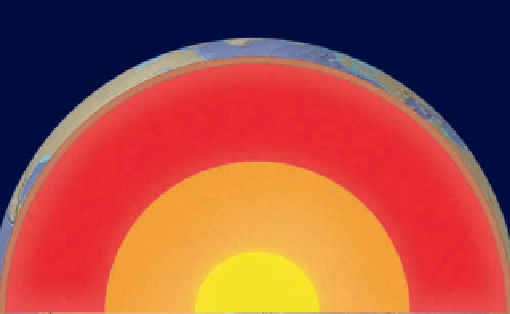Geology Reference
In-Depth Information
◗
Figure 8.22
What If Earth Were Homogeneous?
Oceanic
crust
Continental
crust
20-90 km
3-10 km
70 km
150 km
Asthenosphere (plastic)
660 km
Lower mantle (rigid)
6380-km radius
If Earth were homogeneous
throughout, seismic wave rays
would follow straight paths.
Because density and elasticity
increase with depth, wave rays are
continuously refracted so that their
paths are curved.
a
b
Mantle
Crust
Outer
core
(liquid)
Reflected waves
2900
km
Inner core
(solid)
Refracted waves
3480
km
Focus
Mantle
Earth's Composition and Density
Density
(g/cm
3
)
Outer core
Inner core
Composition
Refraction and refl ection of P-waves as they encounter
boundaries separating materials of different density or elasticity.
Notice that the only wave ray not refracted is the one perpendicular
to boundaries.
c
Continental
crust
Average composition of granodiorite
~2.7
Oceanic
crust
Upper part basalt, lower part gabbro
~3.0
Mantle
Peridotite (made up of
ferromagnesian silicates)
3.3-5.7
In 1906, R. D. Oldham of the Geological Survey of India real-
ized that seismic waves arrived later than expected at seismic
stations more than 130 degrees from an earthquake focus.
He postulated that Earth has a core that transmits seismic
waves more slowly than shallower Earth materials. We now
know that P-wave velocity decreases markedly at a depth of
2900 km, which indicates an important discontinuity now
recognized as the core-mantle boundary (Figure 8.23).
Because of the sudden decrease in P-wave velocity at the
core-mantle boundary, P-waves are refracted in the core so
that little P-wave energy reaches the surface in the area be-
tween 103 degrees and 143 degrees from an earthquake focus
(
Outer core
Iron with perhaps 12% sulfur silicon,
oxygen, nickel, and potassium
9.9-12.2
Inner core
Iron with 10-20% nickel
12.6-13.0
◗
Figure 8.21
Earth's Internal Structure The inset shows Earth's
outer part in more detail. The asthenosphere is solid, but behaves
plastically and fl ows.
the surface (Figure 8.22c). If we know the wave velocity and
the time required for the wave to travel from its source to the
boundary and back to the surface, we can calculate the depth
of the refl ecting boundary. Such information is useful in deter-
mining not only Earth's internal structure, but also the depths
of sedimentary rocks that may contain petroleum. Seismic re-
fl ection is a common tool used in petroleum exploration.
Although changes in seismic wave velocity occur con-
tinuously with depth, P-wave velocity increases suddenly at
the base of the crust and decreases abruptly at a depth of ap-
proximately 2900 km (
Figure 8.24a). This
P-wave shadow zone,
as it is called, is an
area in which little P-wave energy is recorded by seismographs
.
The P-wave shadow zone is not a perfect shadow zone
because some weak P-wave energy is recorded within it. Sci-
entists proposed several hypotheses to account for this obser-
vation, but all were rejected by the Danish seismologist Inge
Lehmann, who in 1936 postulated that the core is not entirely
liquid as previously thought. She proposed that seismic wave
refl ection from a solid inner core accounts for the arrival of
weak P-wave energy in the P-wave shadow zone, a proposal
that was quickly accepted by seismologists.
◗
Figure 8.23). These marked changes
in seismic wave velocity indicate a boundary called a
discon-
tinuity
across which a signifi cant change in Earth materials
or their properties occurs. Discontinuities are the basis for
subdividing Earth's interior into concentric layers.
◗


































Search WWH ::

Custom Search